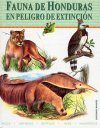About this book
Language: Spanish
Honduras, a Central American country with an area of 112 492 km2, is located in the intertropical zone of the planet and in Mesoamerica; it has a high diversity of terrestrial and marine ecosystems where many animal and plant species occur, whose populations are, by many factors, decreasing dramatically, among others due to: forest fires; forest clearing; environmental degradation by the advance of agricultural frontiers; the development of industry, tourism and pollution from mining activities; and also by the impact of population growth and their demands for goods and services of various kinds to meet their many needs.
All this makes has caused many animal and plant species to slide into a process of irreversible decline, as the balance of these ecosystems is very fragile and, once lost, they can seldom be restored to their original condition. This third edition of Fauna de Honduras en Peligro de Extinción includes 67 species of wild animals, classified into seven categories: corals (1), fish (7), amphibians (9), reptiles (17), birds (15) and mammals (18). The information for each species has been validated by the specialized technical staff of the Instituto Nacional de Conservación y Desarrollo Forestal, Áreas Protegidas y Vida Silvestre (ICF).
Considering the situation of these species and their habitats, the book concludes that there is a genuine interest in protecting and preserving these valuable resources, involving not only the state as the main guarantor, but also various other stakeholders: private companies, unions, media entities, non-governmental organizations and, in particular, all Honduran citizens responsible and sensitive to the environment and the different life forms that dwell in it.
Summary in Spanish:
Honduras, país centroamericano con una superficie de 112 492 km2, ubicado en la franja intertropical del planeta y en el área mesoamericana; cuenta con una diversidad de ecosistemas terrestres y marinos donde habitan muchas especies animales y vegetales, las que por muchos factores están disminuyendo dramáticamente, citándose entre otros: incendios forestales; tala de los bosques; degradación del medio ambiente por el avance de la frontera agrícola y ganadera; el desarrollo de la industria turística y la contaminación de la actividad minera; asimismo, por el impacto del aumento poblacional que demanda y exige bienes y servicios de diversa índole para satisfacer sus múltiples necesidades.
Todo lo anterior, hace que muchas especies animales y vegetales estén en un proceso de franco deterioro e irreversible, pues el equilibrio de dichos ecosistemas es muy frágil y, una vez, perdido, rara vez puede restablecerse a sus condiciones originales. Esta tercera edición de Fauna de Honduras en Peligro de Extinción incluye 67 especies de animales silvestres, clasificados en siete categorías: corales (1), peces (7), anfibios (9), reptiles (17), aves (15) y, mamíferos (18). La información contenida por cada especie ha sido validada por el personal técnico y especializado del Instituto Nacional de Conservación y Desarrollo Forestal, Áreas Protegidas y Vida Silvestre (ICF).
Considerando la situación de dichas especies y sus hábitats, se precisa que haya un genuino interés en proteger y conservar estos valiosos recursos, involucrándose no solo el estado como principal garante, sino que también lo hagan las distintas organizaciones: empresa privada, gremios, medios de comunicación, entidades no gubemamentales y, en particular, todos los ciudadanos hondureños responsables y sensibles ante el medio ambiente y las distintas formas de vida que en él habitan.
Customer Reviews






![Fauna de Honduras en Peligro de Extinción: Peces, Anfibios, Reptiles, Aves, Mamíferos [Endangered Wildlife of Honduras: FIshes, Amphibians, Reptiles, Birds, and Mammals] Fauna de Honduras en Peligro de Extinción: Peces, Anfibios, Reptiles, Aves, Mamíferos [Endangered Wildlife of Honduras: FIshes, Amphibians, Reptiles, Birds, and Mammals]](http://mediacdn.nhbs.com/jackets/jackets_resizer_xlarge/22/223800.jpg?height=620)
![Fauna de Honduras en Peligro de Extinción: Peces, Anfibios, Reptiles, Aves, Mamíferos [Endangered Wildlife of Honduras: FIshes, Amphibians, Reptiles, Birds, and Mammals]](http://mediacdn.nhbs.com/jackets/jackets_resizer/22/223800.jpg)
![Fauna de Honduras en Peligro de Extinción: Peces, Anfibios, Reptiles, Aves, Mamíferos [Endangered Wildlife of Honduras: FIshes, Amphibians, Reptiles, Birds, and Mammals]](http://mediacdn.nhbs.com/jackets/jackets_resizer/22/223800_1.jpg)
![Fauna de Honduras en Peligro de Extinción: Peces, Anfibios, Reptiles, Aves, Mamíferos [Endangered Wildlife of Honduras: FIshes, Amphibians, Reptiles, Birds, and Mammals]](http://mediacdn.nhbs.com/jackets/jackets_resizer/22/223800_2.jpg)
![Fauna de Honduras en Peligro de Extinción: Peces, Anfibios, Reptiles, Aves, Mamíferos [Endangered Wildlife of Honduras: FIshes, Amphibians, Reptiles, Birds, and Mammals]](http://mediacdn.nhbs.com/jackets/jackets_resizer/22/223800_3.jpg)
![Fauna de Honduras en Peligro de Extinción: Peces, Anfibios, Reptiles, Aves, Mamíferos [Endangered Wildlife of Honduras: FIshes, Amphibians, Reptiles, Birds, and Mammals]](http://mediacdn.nhbs.com/jackets/jackets_resizer/22/223800_4.jpg)








![Costa Rica Wildlife Guide: Mammals, Birds, Reptiles, Amphibians, Butterflies [English / Spanish]](http://mediacdn.nhbs.com/jackets/jackets_resizer_medium/19/196493.jpg?height=150&width=65)







